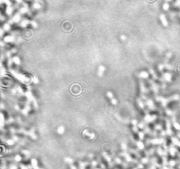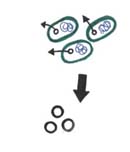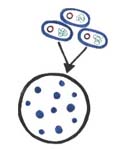|

|
Microbes
and Genetic Engineering
How
Does It Work?
|
7 Basic
Steps
In order
to understand genetic engineering, you need to be familiar
with certain terminology and processes. There are slightly
different methods that can be used to put together DNA from
different organisms. This page focuses on creating
genetically engineered bacteria. For example, if a scientist
knows that gene in humans that makes the enzyme which breaks
down dairy products. Scientists may want copies of this gene
to treat people who get sick from dairy products because
these can't make this enzyme. Scientists would want to
collect copies of this gene from people or make copies by
reactions in a laboratory. This gene could then be
transferred to bacteria. The bacteria can then make the
human enzyme because they now have human DNA in their cells.
The following is a simplified explanation of the general
procedures that would be used to produce a genetically
engineered bacterial cell. There are links to additonal
information that may help clarify concepts for those who
become confused. There are also links that provide more
details for those who want further information on the basic
procedures.
|

|
Step
1: A
gene is picked that controls a trait in which
scientists are interested. DNA containing that gene
is collected from the donor organism that naturally
has this gene. Scientists can also
make
copies of the DNA
in a laboratory if they don't have a lot of
it.
|
|

|
Step
2: Scientists
isolate plasmid
DNA (a ring of DNA in a bacterial cell) from
bacteria. This ring of DNA will carry the gene to
the new organism. The plasmid will serve as a
vector.
|
|

|
Step
3: The
donor DNA and the plasmid DNA are
mixed
with an enzyme
(a molecule that will cause a reaction). This
enzyme
cuts
both kinds of DNA into pieces at special spots
along their code. The pieces that are left are able
to easily join to each other based on their
chemistry. You can think of it like puzzle pieces
that fit together.
|
|

|
Step
4: The
pieces of DNA that have matching shapes or
chemistry join together to make
a complete plasmid
(ring of DNA). This plasmid is now a ring of
DNA that has a new gene as part of the ring.
This new gene is the gene that scientists chose in
Step One to collect from a donor
organism.
|
|

|
Step
5: The
plasmids containing the new gene are mixed with
other bacterial cells. Some of these bacteria will
take the plasmids into their cells by a process
called transformation.
The plasmid will now be inside of these bacterial
cells. These cells now all have the chosen gene
inside of them. The cells containing the gene are
identified and separated from the
rest.
|
|

|
Step
6: Colonies
of bacteria that contain the chosen gene or who can
produce the desirable product are identified and
separated.
|
|

|
Step
7: The
genetically engineered bacteria are grown in large
amounts. The product of the chosen gene can then be
collected from the bacteria.
|
Example
of the Entire Process:
Other
Examples:
TOP OF PAGE
BACK TO MAIN PAGE
© 2000
Jody Becker, Robin Norwood and Brad Greenspan. All Rights
Reserved, except for the images, which retain their own
copyrights.
This site was designed by Jody Becker, Robin Norwood and
Brad Greenspan for MBI 699.W in August of 2000.
|
